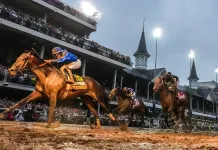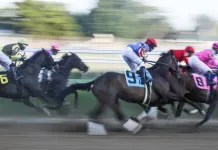Win, Place, and Show Bets
In horse racing betting, the terms “win,” “place,” and “show” refer to different types of bets that predict the finishing position of a horse in a race:
Win:
Betting on a horse to “win” means you are betting that the horse will finish in first place. If the horse you bet on wins the race, you win your bet. This type of bet typically offers higher payouts because it requires the horse to finish in the exact first position.
Place
A “place” bet is a wager that your chosen horse will finish in first or second place. This bet gives you a bit more leeway than a win bet, as it pays out if the horse finishes either first or second. The payouts for place bets are lower than for win bets because of the increased likelihood of winning the bet.
Show
Betting on a horse to “show” means you are betting that the horse will finish in one of the top three positions — first, second, or third. This type of bet offers the highest probability of winning among the three, but it also pays out the least, reflecting the lower risk.
As you move from a win bet to a place bet and then to a show bet, the difficulty of winning decreases, but so does the potential payout. Win bets require the most precision (the horse must finish first), while show bets offer the greatest margin for error (the horse can finish anywhere in the top three).
Horse Racing Betting Tips: Learn the differences between betting on traditional sports vs. horse races
Betting Strategies for Win, Place, and Show
Betting strategies for determining whether to place a win, place, or show bet in horse racing depend on a mix of risk tolerance, horse performance data, and race conditions. Here are some strategies often considered by bettors:
Horse Performance and Track Record
Examine the horse’s past performances. A horse that consistently finishes in the top three could be a safer bet for show, while a horse that often wins may warrant a win bet. Look at their performances on similar tracks and distances.
Assessing the Odds
The odds can give a good indication of a horse’s chances as assessed by the public and experts. Lower odds (like 2-1) suggest a higher chance of winning but offer lower returns, making them potentially good candidates for win or place bets. Higher odds indicate lower chances but higher payouts, which might be more suitable for show bets if the horse still has decent form.
Risk Management
If you’re risk-averse, show bets are more appealing because they offer a higher chance of winning a smaller amount. More risk-tolerant bettors might prefer win bets for the higher payout. Place bets strike a balance between the two.
Field Size
In races with fewer horses, the chances of winning a show bet decrease but the win and place bets become slightly easier to hit. Conversely, in a larger field, show bets might be more attractive due to the increased competition at the top.
Race Conditions and External Factors
Consider the race conditions such as track, weather, and the horse’s performance in similar conditions. Also, evaluate the jockey’s experience and their synergy with the horse.
Bankroll Management
Decide in advance how much of your bankroll to risk on different types of bets. Some bettors prefer to allocate a higher percentage to less risky bets (like show) to maintain their bankroll, while using a smaller portion for higher-risk, higher-reward bets (like win).
Diversified Betting
Some experienced bettors might spread their bets across win, place, and show on different horses in the same race to cover a wider range of outcomes and potentially secure a return even if their top choice doesn’t win.
Ultimately, the choice between win, place, and show betting should align with your betting goals, risk tolerance, and the specific context of each race.






